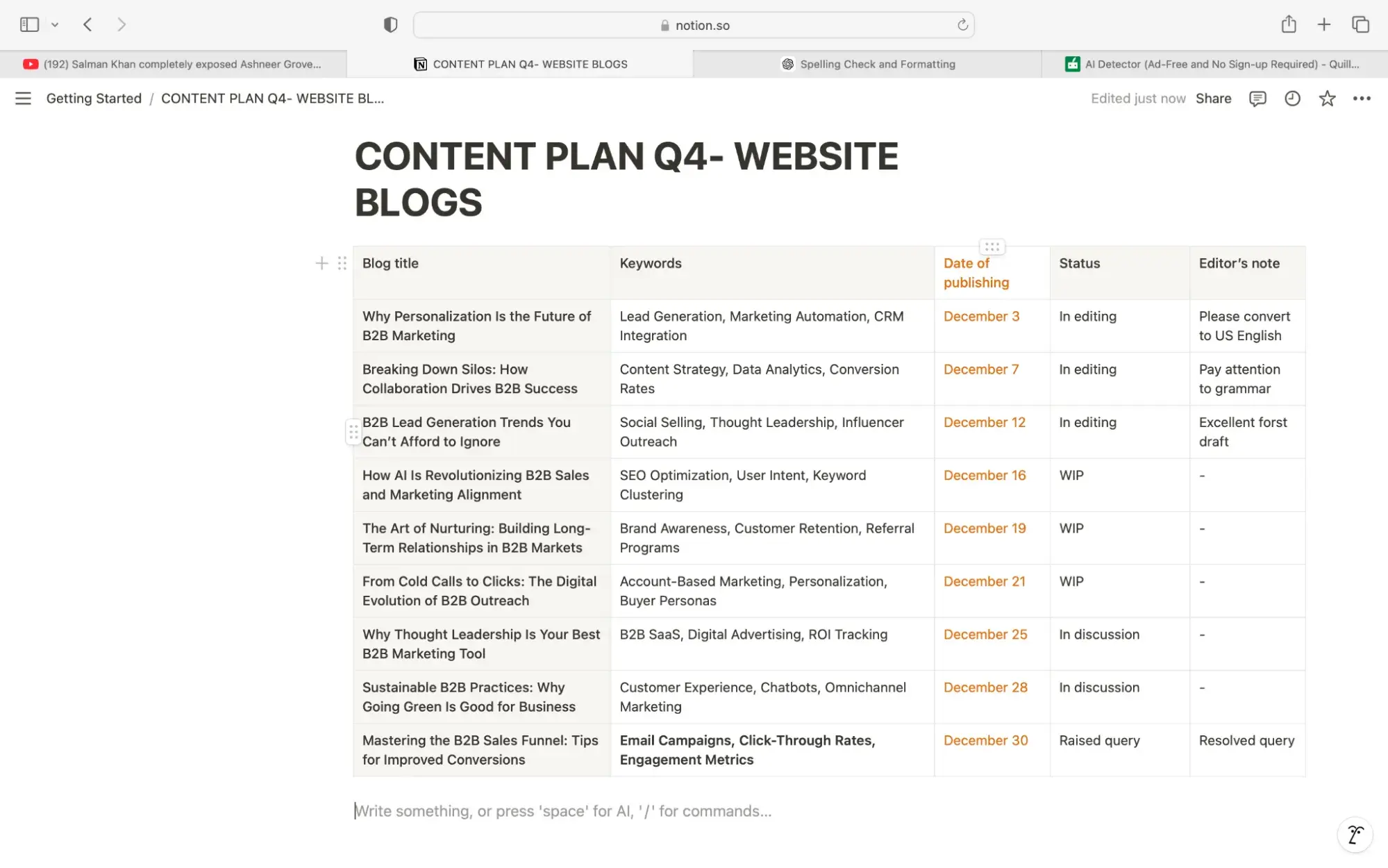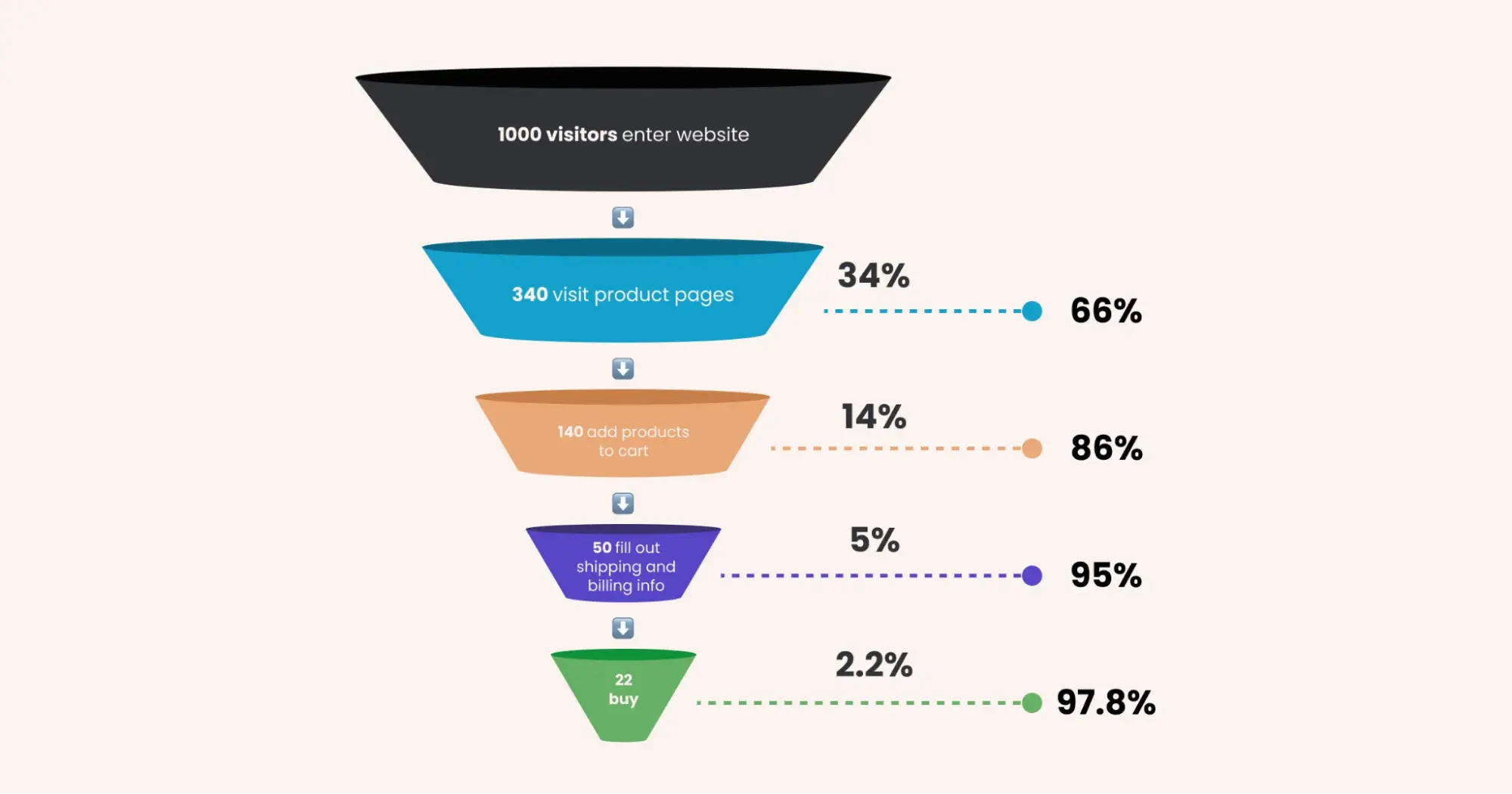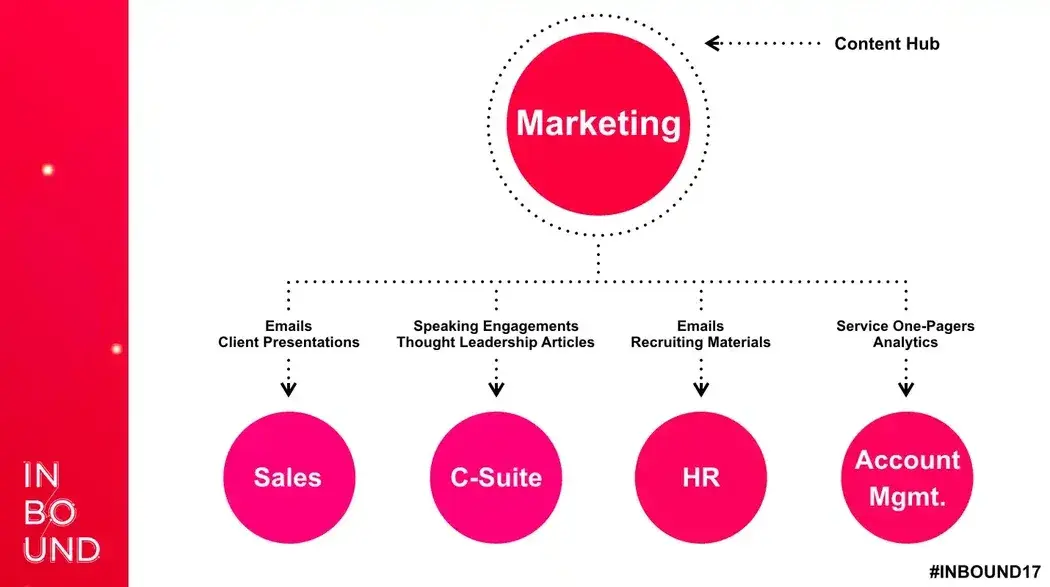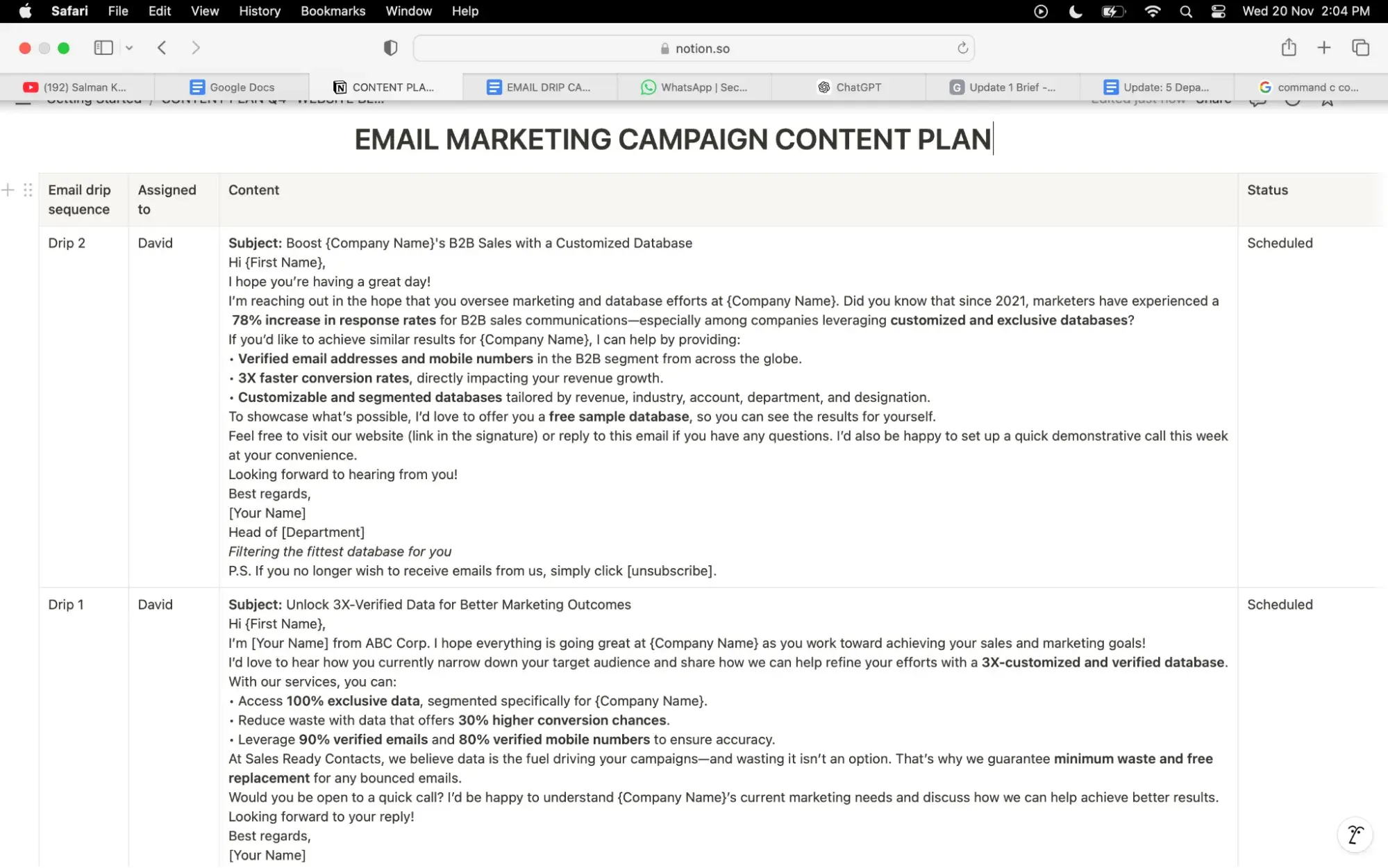The natural assumption about content marketing teams is that we write a bunch of blogs with some SEO guidelines or create some witty social media posts, and voila, the job is done! As an insider, I have seen firsthand that a solid content marketing team does much more than this.
Content is the driver of discoverability for a company, and a solid content marketing team will help you achieve that. The fact that 45% of marketing and media leaders plan to increase their content marketing budget over the next year is a testament to that.
In this blog, I will take you through what a well-structured content department is made of and what it can do to boost your brand growth.
Table of Contents
What makes a high-performing content marketing team?
A high-performing content marketing team is a symphony of strategy, creativity, and execution. Every time I enter a content team discussion, the question at hand is almost always this: How can content teams answer customers‘ questions and also show the brand’s products or services as a solution to their problems?

So, a great content team should know their product like the back of their hand and consistently stay curious about what the target audience is looking for.
As Paul Drecksler, the founder of Shopifreaks, shares: “A high-performing content marketing team comes down to a few key elements: clarity, collaboration, and execution. Everyone on the team needs to know the purpose behind the work. Why is this content being created? Who is it for? How will it be used? Teams that excel are the ones who focus on these answers together rather than working in silos.”
Now, let’s dive deep into understanding what makes a content department a high-performing and vital team.
Consistent Product and Market Research
To stay on top of their game, content teams must consistently research their products.
They need to understand its evolving capacity to fulfill consumer needs, the latest updates, and all the different ways it can be communicated with effective content.
At the same time, content strategy teams must stay very close to their target consumers, researching their problems, challenges, interests, and content consumption patterns.
I would argue that a content marketing team is only as strong as the research they have done, which takes me to the deeper, more holistic part of conducting research.
Overall Industry Trend and Platform Awareness
In this content-driven market, every industry is a cluster of possibilities and challenges, and content marketing teams must be on top of both.
As a content marketing manager, a lot of my attention goes into understanding the bigger challenges of my industry and formulating content to address them.
For example, I once worked for a large organization (one of the largest whey protein powder manufacturers in the country).
During my tenure, several platforms like YouTube and Instagram saw a sudden surge of fear-mongering content that falsely advocated that whey protein is bad for gut health and causes indigestion (which was content mostly pushed by our plant-based protein competitors).
To tackle this, my team and I deliberately produced content using scientific evidence, research papers, and testimonials to reinstate faith in protein powders and debunk the falsely propagated myths.
Doing this not only helped us improve our engagement (comments and shares), but we also saw a significant increase in conversions.
This shows how the content department can ethically construct the overall public opinion about a product to balance the negative trends in the market.
Knowing the industry, the platform, and the current trends is crucial for content strategy teams.
Competitor Content Analysis
I have never met a high-performing content manager who wasn't outrightly obsessed with their competitors. And why not? A smart content marketing team learns from the mistakes of others and uses their triumphs to stay inspired.
As Joe Pulizzi, founder of Tilt and Content Entrepreneur Expo, states, "Content marketing comes down to commitment. There‘s no halfway. You’re either in or you're out!”
Content marketing teams need to be consistent, and consistency comes only when you are completely committed.
Content teams that consistently look into competitor content stay on top of content trends. When they see a certain pattern and keyword repeated among several sources of content, it is often an indicator of gaps in their existing content plan.
Additionally, a competitor analysis also helps the content strategy team find creative and technical gaps in the competitor‘s content, yielding opportunities to use them in one’s own favor. It helps the content marketing teams envision what success looks like in their industry’s content space.
Uncompromised Technical Soundness
This has by far been my biggest learning about the content culture of any organization — you cannot out-achieve with creativity what you under-achieve with technical soundness.
Even the best-laid content plans go astray if the technical execution is not rock solid. For this reason, content teams often have dedicated people assigned to ensure technical efficiency.
They take care of the following:
- Platform optimization. This refers to the action taken to get the best out of the publishing platforms, including ideal word count, image dimensions, video resolutions, etc., to boost visibility.
- Content accessibility. Content teams must make sure that the content is readable without imposing cognitive load onto the reader. They optimize the content with clean fonts and user-friendly layout that guides the reader through the content.
- Cross-browser and cross-device compatibility. Content is crafted with the intention to serve readers using different browsers and devices, so all readers get a similar and optimized experience consuming the content.
- Load-speed. Studies have shown that 40% of site visitors will abandon your website if your page doesn't load in three seconds. So, it is very important to optimize your site to load faster.
Nikola Baldikov, the CEO of InBound Blogging, provides a unique insight into the importance of having members with a technical background in your content marketing team.
“Having team members with a technical background and others with design experience is very beneficial, especially for content projects, as they often require both technical skills and creative problem-solving. Together, these viewpoints can generate ideas that none of the team members could have come up with on their own.”
What I love most about content marketing is that it never works in isolation. Content teams work in a group that comes together to elevate each piece of content to its highest potential.
Content Marketing Roles
I believe a great content team isn‘t just a group of writers. It’s a collective of storytellers, strategists, and visionaries who turn ideas into relationships and words into trust.
Vivian Au, founder of Air Corporate, shared a unique take on building a content marketing team that intrigued me.
She said, "Always say no to traditional hierarchies. A high-performing content marketing team is a specialized rebel. Build a content force who are more psychologists than content creators.
While building my content department, I look for writers who think like journalists, designers who code, and strategists who can decode audience psychology. Monocultures kill creativity."
Now, let me take through some of the key content marketing roles that make a powerful content team.
Content Marketing Manager/Strategist
In larger companies, these roles are often separate from each other, but most companies decide to merge them due to the overlap of responsibilities.
A content marketing manager and/or strategist is responsible for the content calendar consisting of the plan and strategy for content creation, distribution, and feedback cycle.
All subgroups of content — including blogs, case studies, social media posts, email content, newsletters, and even video content — are collectively anchored by the content manager.
It takes about 4-5 years of experience in the content game before one can expect to be promoted to a content marketing manager. Here is an example of what my content calendar for blogs looks like:

If you are a content manager or a strategist, I highly recommend trying out HubSpot's Content Marketing Planning Kit. This detailed guide will help you ideate, plan, and execute content marketing campaigns.
It also has eight easy-to-edit content marketing templates that will make your job much easier.
Content Writer/Editor
Most content marketing managers were once content writers. Content writing is among the most popular and fundamental content marketing roles, as they are easy to access and rather lucrative.
A content writer works closely with the content manager or the team lead to understand the project's objective and execute it within the deadline.
A content writer is expected to be eloquent, with a tight grasp of language and a firm hold on grammar and other technicalities. This should also be paired with the creativity to tell stories with their content. I have spent almost five years as a content writer, and the learning curve is unparalleled.
SEO Specialist
Remember how I established earlier that technical soundness is as important as the content itself? An SEO specialist is a driver of all things technical in content marketing.
SEO specialists focus on ensuring each piece of content is properly optimized for search engines. They are also responsible for researching trending keywords, monitoring SEO rankings, and recommending improvements to boost performance.
Graphic Designer/Visual Content Creator
Personally, graphic designers are my favorite folks! They are responsible for working with the writers and team lead to create exciting pictorial and graphical representations of the content.
They help the blog be more interesting and vibrant and allow readers to scan the content of the blog in a single glance. They also help simplify complex concepts using visual representation.
Here is an example of how visual representation can help simplify complex concepts. For a blog that I was working on, I had to explain how brands can identify website drop-off percentages.
Rather than explaining the whole calculation process, I collaborated with the designers to create this visual representation:

Isn't this much easier to understand in visual form?
Additionally, graphic designers can take a dry piece of content and make it more interesting. Between the diminished attention span of today’s readers — and the endless information bombardment we face — well-designed visuals can help retain readers by conveying immediate value.
Social Media Manager
Although they are a part of the content marketing team, social media managers serve the social media objectives of the company.
They often do their own research and alert the content teams about the evolving trends on social media so the writers can incorporate them into the content strategy.
They also plan and execute strategies for social media content creation and distribution.
Social media managers are among the comparatively more recent roles in the content strategy team.
Analytics and Performance Specialist
Analytics and performance team specialists track content performance using tools like Google Analytics and HubSpot. Analytics team members are usually part of the marketing team.
However, they collaborate with the content strategy team to discuss campaign performance data.
These are some of the most important roles in a conventional content team.
Additionally, companies that produce more video content could have a video producer, too. Several other positions, like UX content specialist, content distribution specialist, and email marketing specialist, can all be additions to the content team as per the organization's needs and requirements.
In my conversation with Peter O'Callaghan, the head of marketing at ScrapingBee, he mentioned, “Our content team includes ex-developers who create tutorials like 'Scraping 101: A Beginner's Guide,' making complex ideas accessible. This guide alone has brought 20% of our traffic in 2023.”
This gives you an idea of how diverse your content marketing team can be based on your target audience and the objective you want to achieve with your content.
Benefits of a Content Department
Remember how I started this article by saying that the importance of a content marketing team is usually underestimated?
To really highlight the bandwidth of a content team and understand the value they bring to an organization, let’s explore the benefits of fostering a strong content department.

1. Powering Marketing With High-Quality Content
Today, marketing is highly dependent on content. For many companies, content marketing is basically their marketing strategy, especially as inbound marketing has continued to gain ground.
Content has become central to every goal you‘re trying to achieve and every tactic you use to reach those goals, so you’re most likely putting it to use in a variety of ways.
Here are three key areas where marketing makes the best use of content:
- Lead generation. My team found that about 18-25% of our quarterly revenue comes from new marketing leads that were generated from content we had written and distributed. If you‘re not using content to attract, nurture, and close leads, you’re leaving revenue and opportunity on the table. (I recommend taking Content Hub out for a spin to help you create and manage personalized content for lead generation, all while letting AI do the heavy lifting.)
- Audience nurturing. No matter what stage of the buyer's journey a lead or customer of ours has reached, use content to educate them — whether they see that content via social media, receive it in their email inbox, or get it from a salesperson.
- Search engine optimization. Pretty much every organization has had to learn about SEO to keep up with audiences and learn how they discover content. Generating your own content helps boost SEO, rankings, and online visibility.
Looking to optimize your content marketing ROI? I suggest you try HubSpot's marketing budget templates (available for both Microsoft Excel and Google Sheets). These templates make it easier to monitor content investments against revenue generation and adjust spending accordingly.
2. Driving Growth With Thought Leadership
Companies don’t have ideas — people do. No matter how many blog posts or articles you’ve read bylined by a brand trying to convince you otherwise, only people have ideas.
Behind every brand is a team of people leading and powering it, and that means there should be people behind the content you create, too.
For a lot of companies, those people often look like founders, CEOs, presidents, or other C-level executives. This is where thought leadership content comes in. In fact, 65% of companies have already started incorporating thought leadership content into their content marketing strategy.
Thought leadership content can benefit the entire leadership team by facilitating:
- Audience connections. People reading your content want to know who’s behind it. It’s great for marketing, but it also gives your company a face and a voice. Your audience members are much more likely to respond to a voice they find compelling and relatable than a faceless company spitting words on a page at them.
- Partnership and co-marketing opportunities. Getting visibility for the people behind the brand can help your brand bring in better collaboration opportunities. And, better collaboration leads to better audience reach.
- Investor relations. If a company is looking to raise another round of funding, chances are good that investors are looking into the people leading that company. Articles or LinkedIn posts showcasing thought leadership and expertise can give your company a leg up on other companies seeking funding.
3. Strengthening Sales With Collateral
You probably already create sales-specific content, whether it's in the form of product or service one-pagers, comparison sheets, proposals, or some other type of sales collateral. But you should go beyond sales-y, promotional content.
The thought leadership content you create on your own (or with other leaders and experts in your company) can also seriously help your sales department.
That's because 45% of decision-makers and 48% of C-suite executives reported that a company's thought leadership directly influenced them to award business contracts.
In my opinion, your content can fundamentally change how your sales team works, so empower all your reps with educational content that enables their processes and encourages them to use it in these three ways:
- Customer outreach. Whether you‘re sending outreach emails, touching base on LinkedIn, or sliding into a client’s DMs on X, I suggest you encourage your sales team to use educational content to spark interest.
- Lead nurture. When a lead has a question for a salesperson, and the right answer is highly involved, I believe content is the perfect way to supplement the sales process and avoid wasting 20 minutes of a sales call answering one detailed question. This applies to email nurture, too; cut to the chase in your communication and supplement the details with your company content.
- Start conversations. Content is a great tool for account-based marketing; use it to attract the attention of that one person whose interest you‘re hoping to pique. You can also ask for their input on a topic you’re writing about. In my experience, people love being asked for their opinions, and it can really strengthen your content.
Here is an example from one of the email marketing campaigns that I worked on in collaboration with the sales team. The campaign targeted decision-makers and achieved a 46% open rate (well above industry standards).
You'll notice how we layered in specific social proof and actionable insights, making the content resonate deeply with our audience rather than settling for generic messaging.

4. Empowering Human Resources With Content
Hiring and training the right people is challenging, no matter which company you work for. But trust me when I say that when your content is integrated into the hiring process, the entire company benefits. Here’s how.
- Recruiting. If you’re hoping to attract candidates who share your values, create content that showcases what your company is all about. Your employees are also more likely to share this kind of culture-focused content than they are to share standard job postings, which can help you tap into the networks of your best brand advocates: current employees.
- Vetting. For candidates who have moved past phone screenings, send select pieces of your content their way before you meet in person. Whether candidates bother to read those articles before their interviews says a lot about their fit for your company. And when those articles are read, they pave the way for more in-depth, illuminating conversations between you and your potential hires.
- Training. Once candidates join your team, send them more content about your company and industry trends to help them prepare for their first day and hit the ground running during their first months with your company.
5. Improving Customer Experience With Content
I’ve often observed that marketing teams view content as a way to generate leads (and even enable sales), but stop short of actually using that content to serve those customers once they sign.
My advice would be to get your content into the hands of your account managers or customer service representatives. Doing this can help you overcome a lot of the same challenges that your sales team uses content to address, including:
- Efficiency. Sometimes, customers ask repetitive questions; other times, they ask really specific questions that require detailed answers. In either case, it’s much easier (and faster) for everyone involved if your account managers can simply give a high-level answer and send content from your subject matter experts that dives deeper.
- Retention and upselling. This method of using content also plays into keeping customers happy enough to stay — and to upsell them on your services.
Continually educating your customers, showing them that you understand the issues they’re interested in, and providing value above and beyond what they may have expected are all good ways to encourage them to keep working with you.
Build Content Teams That Drive Transformation
During my time working in the content field, I have seen that when done right, a content marketing team can become the cornerstone of a company's growth and innovation. But it all comes down to understanding your objectives and building the right team.
While content may start with marketing, it absolutely shouldn't end there. Sharing content between departments — and actively using it as a tool to help every area of the company — is a powerful way to help achieve individual departmental goals and lead your company to success.
Editor's note: This post was originally published in November 2017 and has been updated for comprehensiveness.
Content Marketing



-1.webp)
![How to create a content style guide [+ free guide & examples]](https://53.fs1.hubspotusercontent-na1.net/hubfs/53/image1-May-07-2024-07-15-58-1152-PM.webp)







